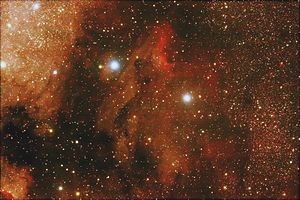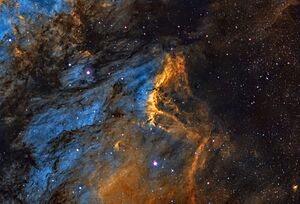Pelican Nebula facts for kids
| Emission nebula | |
|---|---|
| H II region | |

Pelican Nebula (IC5070 and IC5067)
|
|
| Observation data: J2000.0 epoch | |
| Right ascension | 20h 50m 48.0s |
| Declination | +44° 20′ 60.0" |
| Distance | 1,800 ly |
| Apparent magnitude (V) | 8.0 |
| Apparent dimensions (V) | 60' x 50' |
| Constellation | Cygnus |
| Designations | IC 5070 and IC 5067 |
The Pelican Nebula is a huge cloud of gas and dust in space. It is also known as IC 5070 and IC 5067. This nebula gets its name because its shape looks a lot like a pelican bird.
It is found in the constellation of Cygnus, which is also called the Swan. The Pelican Nebula is very close to another famous space cloud, the North America Nebula. A dark cloud of dust separates these two nebulae.
Contents
What is the Pelican Nebula?
The Pelican Nebula is a type of space cloud called an H II region. This means it is a cloud of hydrogen gas that has been ionized. Ionized gas is gas that has lost some of its electrons. This happens because of strong energy from nearby hot, young stars.
The nebula is also an emission nebula. This means it glows brightly because the ionized gas gives off its own light. It is located near a very bright star called Deneb.
Star Formation in the Pelican Nebula
Scientists study the Pelican Nebula a lot. This is because it is a very active place where new stars are being born. It has a mix of gas clouds that are changing and young stars forming.
The bright light from these new, energetic stars slowly heats up the cold gas around them. This creates something called an ionization front. This front slowly moves outwards, changing the gas from cold to hot.
Gas Clouds and Jets
Even with all the heat, some parts of the nebula are still very dense and cold. These parts look like thick threads of gas. Inside these cold threads, scientists have found two jets of material. These jets come from a special type of young star system called a Herbig–Haro object. The jets are named Herbig–Haro object 555.
Over millions of years, the Pelican Nebula will change. The stars and gas will move and shift. Because of this, the nebula might not look like a pelican anymore in the distant future.
See also
 In Spanish: Nebulosa Pelícano para niños
In Spanish: Nebulosa Pelícano para niños


